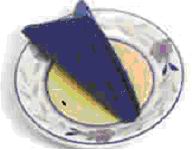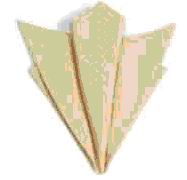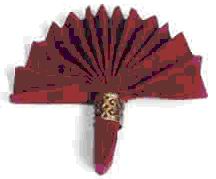D/S LIFESTYLE
Formal Dining
Part 3-Napkins and Wine Glasses
By Toran's soft
Napkin Magic:
You can use either cloth or paper napkins - they each have their own advantages. Paper napkins hold their shape better. They work really well for fold styles that have crisp edges and creases. Cloth napkins undoubtedly give your table a more elegant look and work well when the fold style has a flowing design. If you use cloth for fold styles that have crisp folds be sure to starch them well so they hold the crease better.
Fancy folds are beautiful indeed and can really jazz up your table. If you have white dinnerware and table clothes then try using a coloured napkin to add some spark and pop to your table.
Tips:
- Always work on a clean, dry surface.
- Most designs call for a square napkin. So, if you only have rectangular ones use paper napkins and trim the edges to create a square.
- Using a napkin with a right and wrong side makes it easier to see what's what.
- Avoid all cotton or linen when the design needs to 'stand' on its own. Even when starched they have a harder time holding the crease.
- Cloth napkins are best suited to a more flowing or spreading design would be best for these types of material.
Napkin Folds:
Following are instructions for three napkins folds.
 |
The Basic Fold:
|
 |
The Tulip Fold:
|
 |
Accordion Napkin Fold:
Note: This one needs napkin rings too.
|
Wine Glasses:
Did you know that not only does your table and wine look better with the right glass, but also it can actually make it taste better? Apparently so! Both the aroma and the flavour of a wine can change slightly by how much the wine can breathe in the glass. So, as a result different shapes allow the wine to breath differently and thus can enhance your wine.
There are several shapes and sizes of wine glasses. However, there is no 'proper' glass in which to serve wine, nor is there a 'proper' shape. There are though a few common wine glass shapes designed to enhance the aroma and flavour of the wine:
 |
|
 |
|
 |
|
 |
|
Tips:
- Though there are several types of wine glasses you don't need to have them all to enjoy your wine. If you're on a budget or only have one type, get a tulip-shaped one. Though it's recommended for white wine it is suited to multi-purpose.
- Tulip shape is also often referred to as the 'chimney' shape - basically the bottom of the bowl is larger, fuller than the top where it tapers slightly.
- Smaller glasses should be used for wines or spirits with a lighter bouquet than wines. For example, they are well suited to liqueurs or ice wines, etc.
- Tall glasses with a narrow bowl are used for champagne to enhance the visual aspects of the wine. Bottom line - they let you see the bubbles better.
- Choose clear glasses. If you use a coloured glass you're taking away from the colour of the wine in the glass.
- Glasses made of good, thin glass are best unless you have money to throw around.
- If you don't mind spending the money then a good crystal glass looks nicer and adds sophistication to your table setting.
- Be sure not to fill a wine glass too full, one third to one half full at the most. You want to leave room for your wine to breathe.
Wine Temperature:
You may have heard that red wine should be served at room temperature and that white wine should be slightly chilled before serving. Well, yes and no. When these recommendations first came out "room temperature" was lower than is typical today.
- Full-bodied red wines are best enjoyed at not more than 64°F (18°C)
- Clarets, Pinot Noirs (including burgundies), Beaujolais and then the other reds that are not 'aged' but are drunk when they are quite soft, light, fruity and relatively young, should be served at slightly cooler temperatures down to about 54°F (12°C).
- White wines are ideally served between 43°F (6°C) to 52°F (11°C).
- Whether red or white if you aren't sure of the temperature it's best to serve them cooler than too warm. They'll warm up naturally as you serve them.
© THE BDSM CIRCLE / LE CERCLE BDSM 2006